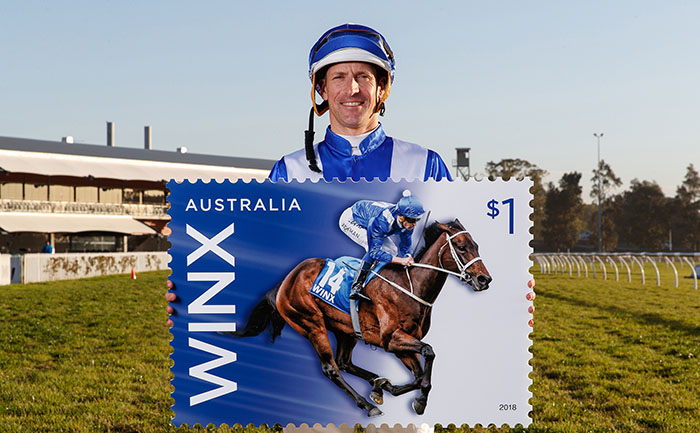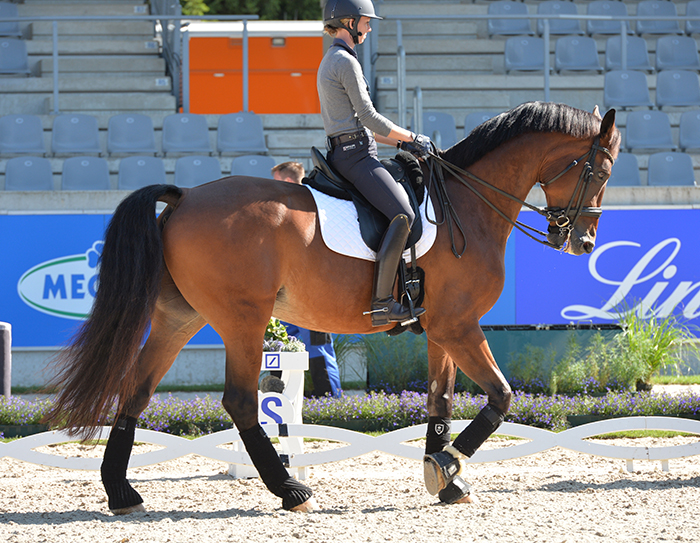The Equestrian World has long benefitted from the insights and the scientific approach of Dr Andrew McLean. Like all enquiring minds, Andrew is always looking to new fields of research. Here Dr McLean analyses the length of stride of the champion racehorse, Winx, and finds real connections between training for equestrian sport, and the racetrack…
Winx.

David Swift photography –
A new stamp will soon be available featuring Winx and Hugh Bowman, who rode Winx in her record-breaking win.
Winx is the most extraordinary racehorse of our time. It is not just because she keeps on winning and breaking all the records of straight wins, it is the way she wins. All of the champions of the past have tended to lengthen their stride on the home straight and in doing so, their tempos (the speed of the stride) slow a little or a lot. For example, Black Caviar had a stride length of well over 8 m. On the home turn her tempo was around 145 bpm, yet when she cruised to the finish line, her tempo decreased to less than 130 bpm.
By comparison, Winx is a jackrabbit, her stride length is quite short (under 7m) but her tempo can increase to well over 160 bpm. That is truly an amazing biological feat for an animal as large as a horse. She must have an extraordinary neural firing ability. No other champion racehorse, to my knowledge, has accelerated to that frenetic level. I have measured American Pharaoh, Secretariat and a few other American greats, as well as our own Kingston Town, Makybe Diva, Chautauqua and many others and they all tend to adopt the Black Caviar model of lengthening once they’ve rounded the home turn, although some do a bit of both – they lengthen but also increase tempo slightly. But none can match the outrageous tempo of Winx.
The two main variables of forward moving are stride length, and tempo, and for a few years now, I have been emphasising the importance of having easily discriminated aids for these two variables in the sport horse.

For the dressage horse the distinction between stride length and tempo is fundamental for any degree of success. In the young horse it is well worth teaching him to be able to quicken and slow the walk, as well as lengthen and shorten it, so that later we are able to both shorten and maintain a quicker tempo, as in collected walk. A too slow collected walk is doomed for low marks. Tempo and stride length control translates to the other gaits also as training progresses. Imagine if racehorse trainers adopted the same schooling principles for racehorses, and if jockeys were taught these different cues, how this would have a predictable effect on racehorse performance.
Winx is also apparently very trainable. Obedience is very important in all horse sports, and none more so than racing. By obedience I mean an immediate response from a light aid. I vividly recall how when Makybe Diva won the Melbourne Cup, she stood there at the end of the race, parked on the spot like a statue, while the jockey fisted the air with both hands. And I vividly recall how Lonhro won the Australia Cup when he was hopelessly boxed in. The jockey deftly manoeuvred him and then gave a nudge with his heels and off the horse galloped to victory. I think paying attention to training can make a huge difference. When horses have poor training, they are more likely to become overly stressed and their increased adrenaline has an analgesic effect so they aren’t able to respond to light aids at that time.
Many years ago, I was the behaviour consultant for Peter Hayes who was Australia’s leading trainer for many months after his untimely death. I had enormous admiration for his intellect and especially his enquiring mind. Peter and I had quite a few chats over dinner about training, and he asked me if there was anything I could see at Lindsay Park that could be improved behaviour-wise, to give him a greater edge in the racing scene. These discussions led to teaching the staff there systematic ground work so that all horses led in a calm, predictable and confident way. I told him of Geoff Hutson’s solid research at Melbourne University with data from thousands of racehorses that conclusively showed that if horses led calmly in the saddling enclosure, they were far more likely to be winners than losers. At Lindsay Park we also began to develop the idea of teaching horses to turn correctly and evenly in both directions, just a stride or two to the right and left, releasing the rein pressure for each stride of turning in the warm-up trot on the training track so that the horses would learn to go straight rather than requiring lugging bits to ‘hold them straight’. Sadly Peter was killed in a plane crash before we could solidly implement all of the possible training improvements.
It’s interesting that practically all of the great racehorses of our time were not whipped, while the others, the stragglers, had the whip drawn on them. Winx famously won when the whip was dropped by the jockey, Hugh Bowman at the 300m mark. The background narrative is always the same: there is something special, almost spiritual about these icons that run to please us. But logically, if we turn this notion upside down, we might see that the greatness of these horses may to some extent have been because they didn’t get the whip drawn on them. The whip, by and large can prevent the emergence of truly great racehorses, and that is aside from the growing public and welfare concerns about the use of the whip in horse racing. The behavioural reason why the whip in racing can do more damage than good, is partly because in most cases the pain produces no effective response, which is mentally damaging for any animal. As Tom Roberts famously said: “the greatest kindness you can do for any horse is to educate him well”. I think Tom would have agreed that a great racehorse also happens to be a well-trained one, by either default or design.
Here’s her latest win, the Winx Stakes.
Andrew McLean, PhD
CEO, Equitation Science International (ESI) RTO: TOID 41254 | Behaviour Consultant, Melbourne University Veterinary Hospital | Honorary Associate, University of Sydney | Honorary Fellow, International Society for Equitation Science (ISES) | Director, Pony Club Australia | Chairman, Human Elephant Learning Programs (The HELP Foundation Ltd) | Member IUCN SSC Asian Elephant Specialist Group

What a wonderful article.I am a breeder,owner and a rider.The racing industry really would benefit from this article which I will duly pass on.
I have watched Winx ,Black Caviar and Makybe Diva in replay looking for that freakish quality.You can see a lot in slow-mo.While everyone,including myself plow through pedigrees looking for the holy grail,we should be looking (as well) into more bio-mechanics.
Thank you…regards..’still learning’.
Interesting also that both Winx and BC always seemed to ridden on a much longer rein than most horses. Even in the early stages of a sprint race, when the speed was on from the start, she seemed to be able to ease the pace or park behind the leaders without pulling and still on a longer rein than the other horses – no wasted effort in trying to go faster against the jockey’s wishes. And then whoosh instant acceleration when asked for, even when there was no visible signal from the jock. Winx the same. Always thought these two were the product of excellent foundation training and handling afterwards in their education.